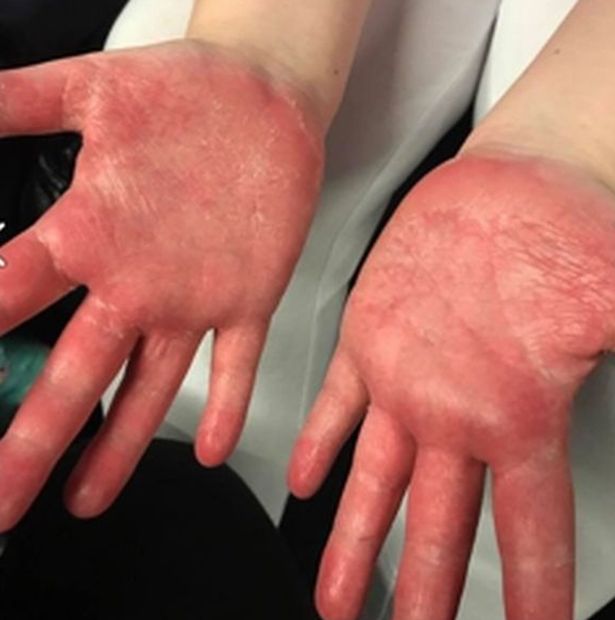

CHEMICAL BURN SCAR SKIN
Burns are painless with no sensation to touch, skin is pearly white or charred, dry and may appear leathery.Subcutaneous fat tissue, muscle and bone may also be involved in very severe burns.Nerve endings, small blood vessels, hair follicles, sweat glands are all destroyed.Most severe burn and involves all layers of skin – epidermis and dermis.Deep partial thickness burns may or may not be painful ( nerve endings destroyed), may be moist or dry (sweat glands destroyed), hair is usually goneįull thickness or third degree burn signs and symptoms.Superficial partial thickness burns are usually painful, red, moist, with blisters, hair still intact.Depending on the how much of the dermis is affected the burn is further broken down into superficial or deep.Involves the epidermis and some portion of the dermis.Partial thickness or second degree burn signs and symptoms May be painful, red and warm, area turns white when touched, no blisters, moist.Superficial or first degree burn signs and symptoms

The signs and symptoms experienced by a burn victim depend largely on the severity of the burn and the number of layers of skin that are affected. Nowadays many doctors describe burns according to their thickness (superficial, partial and full). Traditionally thermal injuries were classified as first, second or third degree burns. This is not part of the skin but attaches the skin to underlying bone and muscle as well as supplying it with blood vessels and nerves. Lying below the dermis is the hypodermis or subcutaneous fat tissue. It also contains hair follicles, sebaceous glands and sweat glands. Hence, the dermis is richly supplied with blood vessels, lymphatic vessels and nerves. The epidermis does not contain any blood vessels but is nourished via the blood vessels located in the dermis.

The epidermis consists of epithelial cells among which are the pigment-containing cells called melanocytes, which absorb some of the potentially dangerous UV rays in sunlight. Basically, skin consists of an outer layer called the epidermis and an inner layer called the dermis. For additional information visit Linking to and Using Content from MedlinePlus.To understand the nature and classification of thermal burns it is necessary to have a brief understanding of how skin is made up. Any duplication or distribution of the information contained herein is strictly prohibited without authorization. Links to other sites are provided for information only - they do not constitute endorsements of those other sites. A licensed physician should be consulted for diagnosis and treatment of any and all medical conditions. The information provided herein should not be used during any medical emergency or for the diagnosis or treatment of any medical condition. This site complies with the HONcode standard for trustworthy health information: verify here. Learn more about A.D.A.M.'s editorial policy editorial process and privacy policy. is among the first to achieve this important distinction for online health information and services. follows rigorous standards of quality and accountability. is accredited by URAC, for Health Content Provider (URAC's accreditation program is an independent audit to verify that A.D.A.M. Do not give aspirin to children under age 2 years, or anyone 18 or younger who has or is recovering from chickenpox or flu symptoms.Ī.D.A.M., Inc. These include acetaminophen (such as Tylenol), ibuprofen (such as Advil or Motrin), naproxen (such as Aleve), and aspirin. For pain, take an over-the-counter pain medicine.Do not use a dressing that can shed fibers, because they can get caught in the burn. If needed, protect the burn from rubbing and pressure with a sterile non-stick gauze (petrolatum or Adaptic-type) lightly taped or wrapped over it.Do not use cream, lotion, oil, cortisone, butter, or egg white. Some antibiotic ointments can cause an allergic reaction. The ointment does not need to have antibiotics in it. You may put a thin layer of ointment, such as petroleum jelly or aloe vera, on the burn.Clean the burn gently with soap and water.If it is deeper, larger, or on the hand, foot, face, groin, buttocks, hip, knee, ankle, shoulder, elbow, or wrist, seek medical care right away. After the burn is cooled, make sure it is a minor burn.


 0 kommentar(er)
0 kommentar(er)
